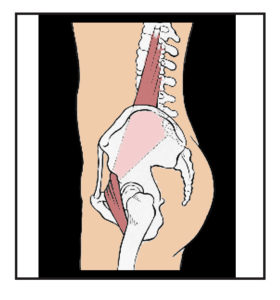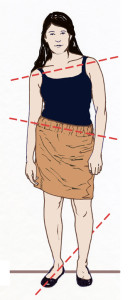Have you heard of the psoas muscle?
It is pronounced s0-az. The P is silent.
The psoas is one of the body’s most essential muscles because, along with only two other muscles, it connects the upper and lower body. And it is the only muscle connecting the legs to the spine at the front of the body.
The two other muscles connecting the the legs to the spine, the piriformis and gluteus maximus, work together with the psoas to keep the pelvis and trunk upright on top of the legs.
I should clarify and say they are meant to work together but very often tightness, or weakness, or a combination of the two, leaves the balance of the upper and lower body in dissaray.
You have two of these muscles, one on either side of the spine running down to attach on the back inner thigh. When one or both of your psoas is tight the effects can be profound.
Let’s start by looking at what a well aligned psoas muscle can do for the body.
In general we are tighter on one side of the body so it follows that one psoas is always tighter than the other but when that tightness becomes exagerrated, for any number of reasons, it can lead to all manner of back, hip and groin pain.
If the psoas muscle is happy it keeps the lumbar spine in its natural curve and allows the muscles of the spine to lengthen up supporting the whole trunk. But lets say that on the left side you have a tight psoas muscle, that left leg bone will be pulled up into the hip socket slightly.
This accounts for the concept of leg length discrepancy. We all have one leg shorter than the other and this is almost always the result of your tight psoas muscle. In some cases there might actually be a difference in the size of the bones, especially in the case of blunt force trauma such as car accidents and such, but for the most part leg length discrepancy is due to a tight psoas muscle.
The pull of the tight psoas muscle that you can see in the picture above is a fairly classic pattern. I know that at any of my workshops I’ll be able to bring numerous people to the front of the room that exhibit this exact pattern.
And this pattern can be the cause of a many different manifestations of pain. General back pain but also knee and shoulder pain. Releasing the psoas via exercises and posture work can help you find relief that we often think is no longer available.
When one psoas is tighter than the other, the leg is pulled up into the hip socket on the tight side, which limits the mobility of the hip joint, and since one of the basic functions of the psoas is external rotation, that leg is often turned out more than the other.
In the trunk the image above shows that a tight psoas muscle can shorten the body on the tight side. This tightness manifests by a pulling up on the hip socket and a pulling down on the shoulder drawing the two bony landmarks closer to each other.
This is a little counter-intuitive because you might be thinking that if the right hip is higher the right shoulder should be higher as well but the tight psoas constricts that entire side of the body.
This is just one variation on the pull of a tight psoas. More severe tightness can lead to scoliosis and in extreme cases a hunchback.
Gentle release work that almost anyone can do can help you find relief from so many nagging issues that go undiagnosed and often leave you without any hope of healing because doctors, MRI’s and x-rays often report that seems to be no problem.

